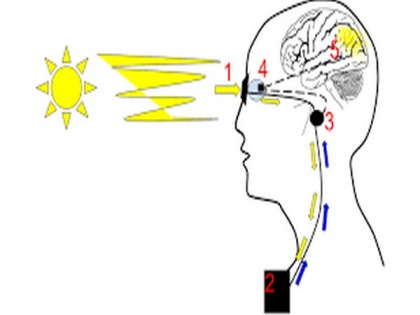Brain can combine natural, artificial vision to help treat common form of blindness
By ANI | Published: December 30, 2019 12:19 PM2019-12-30T12:19:14+5:302019-12-30T17:51:18+5:30
A new research has found that the brain knows how to integrate natural and artificial vision while maintaining information processing that is important for the vision which can help in better treatment for age-related macular degeneration (AMD).

Brain can combine natural, artificial vision to help treat common form of blindness
A new research has found that the brain knows how to integrate natural and artificial vision while maintaining information processing that is important for the vision which can help in better treatment for age-related macular degeneration (AMD).
The study published in the 'Current Biology' journal mentioned that AMD in the West causes blindness in millions of people. In the Western world, it is the most common cause of serious vision loss for those aged 50 and over and is growing with age. Although no remedy is available for AMD, recent significant advances in artificial retina implants may contribute to effective treatment.
Located inside the eye the retina contains light receptors (photoreceptors) that absorb light. Information is then processed and transmitted to the brain.
The macula, the central area of the retina, processes most of the information that reaches the brain from the eye, enabling one to see while reading and driving, facial recognition, and any other activity that requires accurate vision.
In the peripheral retina, the area of the retina outside the macula that assists mainly with spatial judgment, vision is 10-20 times less precise.
In AMD, precise vision is impaired due to damage to the centre of the retina, while peripheral vision remains normal.
When there is damage to the photoreceptor layers in the retina, an artificial retina may be implanted. Activating these electrodes results in electrical stimulation of the remaining retinal cells and results in the visual restoration, albeit partially.
AMD patients implanted with an artificial retina possess a combination of artificial central vision and normal peripheral vision. This combination of artificial and natural vision is important to study in order to understand how to help the blind.
One of the key issues here is whether the brain can integrate artificial and natural vision correctly.
In the course of her PhD studies, Tamar Arens-Arad has used a unique projection system that stimulated either natural vision, artistic vision or a combination of natural and artificial vision and at the same time records cortical responses in rodents implanted with a subretinal implant.
The implant is made up of dozens of small solar cells and electrodes developed at Stanford University by Prof. Del Palanker.
These groundbreaking findings have implications on better vision restore for retinal prosthetic implanted in AMD patients and help the theory of incorporation of prothetic and natural vision into the brain.
The findings can also have an impact on future brain-machine interface systems where artificial and natural procedures co-exist, said Professor Yossi Mandel, Head of the Ophthalmic Science and Engineering Lab.
( With inputs from ANI )
Open in app